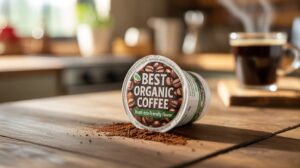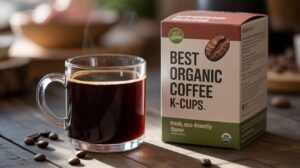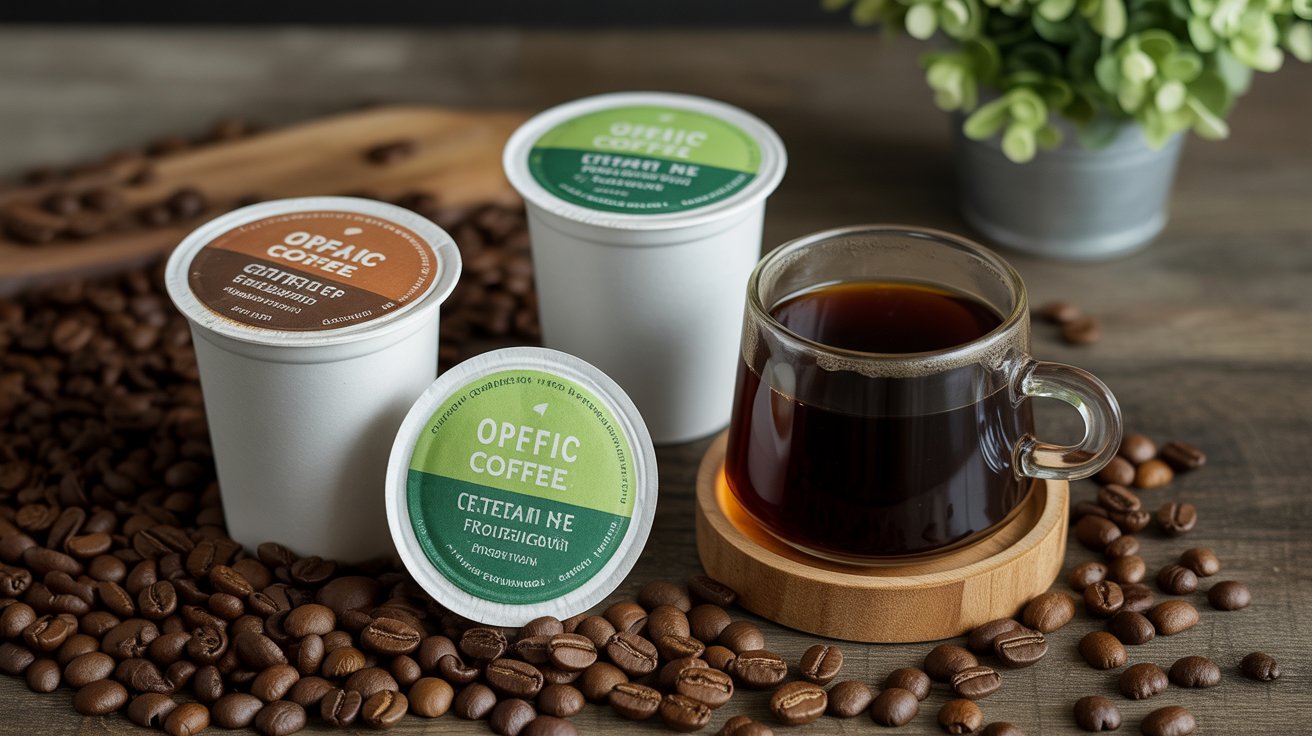If you’re wondering whether organic coffee K cups are really worth it, here’s the short answer: yes—if you care about what goes into your body and the planet.
Most people don’t realize that standard pods often contain pesticide-treated beans and non-recyclable plastics. That means you’re paying for “convenience” at the cost of your health and the environment.
I learned this the hard way after noticing my morning cup tasted… off. Once I switched to organic pods, the difference was night and day—cleaner flavor, less bitterness, and peace of mind knowing the beans were grown without chemicals.
In this guide, I’ll break down how to choose the best options, which brands actually deliver, and how to avoid the greenwashed “organic” labels that don’t live up to their name.
What Makes a K-Cup Truly “Organic”?
The word “organic” isn’t just a fancy label—it’s a certification backed by strict farming and manufacturing standards. If your K-cup doesn’t meet those standards, it’s not truly organic, no matter what the marketing says.
Organic Certifications (USDA, Fair Trade, Rainforest Alliance) — Why They Matter
Think of certifications as your shortcut to trust.
USDA Organic means the coffee was grown without synthetic pesticides, herbicides, or GMOs.
Fair Trade ensures farmers are paid fairly, often improving living conditions in regions like Colombia, Ethiopia, or Honduras.
Rainforest Alliance adds another layer, focusing on biodiversity, soil health, and climate resilience.
If you don’t see one of these seals, the “organic” claim is just packaging hype. In fact, a 2024 consumer study by Statista showed that 63% of U.S. buyers look for the USDA seal before choosing organic coffee pods—because they know it’s the gold standard.
Common Myths vs. Reality
Myth 1: “Organic = chemical-free.”
Reality: Organic farming still uses natural pesticides (like neem oil). The difference is they’re far less toxic than synthetic ones used in conventional farming.Myth 2: “All compostable pods are organic.”
Reality: Pod material ≠ coffee quality. You can have a compostable pod filled with conventionally grown beans. Always check both the pod AND the coffee source.Myth 3: “Organic tastes weaker.”
Reality: Flavor depends on roast and bean origin—not certification. Many organic K-cups (like Lifeboost or Newman’s Own) are bold, full-bodied, and rival premium café blends.
Latest Safety Data and Health Concerns
Here’s the part most blogs skip: not all organic K-cups are created equal.
A 2025 report in Environmental Health Perspectives revealed trace contaminants in multiple “organic” coffee products due to lax supply chain audits. Translation? Just because a box says “organic” doesn’t mean every pod inside is 100% clean.
Smart buyers look for brands that publish third-party lab results or emphasize single-origin sourcing for traceability. Companies like Tayst Coffee Roaster even highlight eco-friendly pod construction alongside USDA certification, giving you peace of mind on both quality and packaging.
Why Choose Organic K-Cups — Beyond Taste

Going organic isn’t only about flavor—it’s about health, sustainability, and impact. Let’s break it down.
Health Benefits (No Synthetic Pesticides, Better Purity) — Tayst Coffee Roaster
When you brew a pod from a certified organic roaster like Tayst, you avoid exposure to synthetic pesticides and fertilizers commonly used in commercial beans. That means fewer toxins in your cup—and often a smoother, low-acid profile that’s easier on digestion.
Many health-conscious coffee lovers report fewer jitters and stomach issues when switching to organic pods. It’s not magic; it’s simply cleaner farming and better bean quality.
Environmental Impact: Compostable Pods, Recyclability, Eco-Conscious Packaging
K-cups earned a bad rap for landfill waste. Organic-focused brands are fixing that.
Compostable Pods: Tayst, San Francisco Bay, and Glorybrew offer pods that break down naturally.
Recyclable Plastics: Some use #5 polypropylene pods compatible with most local recycling programs.
Minimal Packaging: Companies now ship in recycled cardboard or biodegradable sleeves to reduce footprint.
This shift matters—Americans use an estimated 25+ billion pods annually, and eco-friendly designs directly reduce that impact.
Ethical & Sustainable Sourcing: Fair Wages, Biodiversity, Farming Practices
Behind every pod is a farmer. Choosing organic means you’re more likely supporting co-ops and farms that:
Pay workers fairly (Fair Trade certification verifies this).
Protect biodiversity (shade-grown coffee encourages bird and insect habitats).
Maintain soil fertility (organic farms use composting, cover crops, and crop rotation instead of chemical fertilizers).
Brands like Newman’s Own Organic and Green Mountain often highlight these practices, giving you coffee with a conscience.
Top Rated Organic K-Cup Options (2025)

You don’t need to scroll through endless Amazon reviews or sift through brand hype. Here are the best organic coffee K-Cups for 2025, ranked by taste, certifications, and real-world usability.
Best Overall — Lifeboost Organic Coffee Pods
Lifeboost consistently tops buyer’s guides (including Lifeboost Coffee’s own curated rankings) for one reason: they balance purity, taste, and health.
Why it wins: USDA Organic certified, mycotoxin-tested, single-origin beans from Nicaragua.
Flavor profile: Smooth, low-acid, chocolatey notes.
Perfect for: Coffee drinkers who want clean beans and bold flavor without stomach irritation.
Lifeboost is the brand health-conscious coffee lovers rave about.
Best Value — Newman’s Own Organics Special Blend K-Cups
Newman’s Own proves organic doesn’t have to mean expensive.
Why it wins: Affordable price per pod (often under $0.70 when bought in bulk).
Certifications: USDA Organic + Fair Trade Certified.
Flavor profile: Medium roast, balanced acidity, approachable for daily brewing.
Perfect for: Families and offices looking for organic coffee without premium pricing.
Best for Flavor Variety — Green Mountain Organic Line
Green Mountain (a Keurig-owned brand) delivers something most organic lines don’t: wide roast and flavor variety.
Options: Dark Magic, Ethiopia Yirgacheffe, Breakfast Blend, and seasonal organics.
Certifications: USDA Organic.
Why it wins: You can change it up daily without leaving the organic category.
Perfect for: Curious drinkers who want a rotating flavor experience.
Best for Health-Conscious / Low-Acid Options — Puroast Organic Low-Acid Coffee Pods
If coffee usually leaves you with heartburn or jitters, Puroast is worth a look.
Why it wins: Naturally low-acid beans with 70% less acidity than conventional pods.
Certifications: USDA Organic.
Flavor profile: Nutty, smooth finish; easy on sensitive stomachs.
Perfect for: Health-conscious drinkers who love coffee but hate digestive issues.
Best Compostable or Eco-Friendly Pod — San Francisco Bay OneCup Organic Rainforest Blend
San Francisco Bay Coffee is one of the few mainstream brands tackling the landfill problem head-on.
Why it wins: Pods are made from plant-based compostable materials.
Certifications: USDA Organic + Rainforest Alliance.
Flavor profile: Bold, full-bodied, earthy tones.
Perfect for: Eco-minded buyers who want both a rich cup and a lighter footprint.
Read Also:
How to Choose the Right Organic K-Cup for You
Not all organic pods are created equal. Here’s a step-by-step process to find your perfect match.
Step-by-Step: From Roast Preference → Certification → Flavor → Price → Sustainability
Pick your roast: Light (bright, acidic), medium (balanced), or dark (bold, smoky).
Check the certification: Look for USDA Organic, and bonus points for Fair Trade or Rainforest Alliance.
Flavor test: Do you prefer chocolatey Central American beans, fruity African origins, or nutty South American blends?
Compare the price-per-cup: Value brands like Newman’s Own sit under $0.70; premium pods like Lifeboost hover at $1.20+.
Factor in sustainability: Compostable pods (San Francisco Bay, Tayst) reduce environmental guilt.
Use-Case Scenarios
“I want bold flavor under $1.00/cup.” → Newman’s Own Organics or San Francisco Bay OneCup.
“I need low-acid for digestion.” → Lifeboost or Puroast low-acid pods.
“I care most about eco-friendly packaging.” → San Francisco Bay or Tayst compostable pods.
“I want variety without losing organic quality.” → Green Mountain Organic lineup.
Pro tip: Buy a mixed sample pack first. That way, you can try multiple brands before committing to a 72-count box.
Pros & Cons of Organic K-Cups vs. Conventional Pods
When deciding between organic and conventional coffee pods, the trade-offs are clear. Organic pods win on health and sustainability. Conventional pods win on price and availability. Here’s the breakdown.
Pros: Purity, Traceability, Environmental Credentials
Purity: Organic beans are grown without synthetic pesticides or chemical fertilizers. Brands like Lifeboost Coffee and Newman’s Own Organics publish third-party test results showing lower toxin levels and cleaner beans.
Traceability: Many organic pods highlight single-origin sourcing—Nicaraguan, Ethiopian, or Colombian beans—so you know where your coffee comes from. Conventional blends rarely provide this transparency.
Environmental Credentials: USDA Organic, Fair Trade, and Rainforest Alliance certifications ensure eco-friendly farming. Compostable pods from San Francisco Bay Coffee or Tayst further reduce waste, helping offset the 25+ billion pods Americans discard each year.
Bottom line: If you value health, transparency, and sustainability, organic pods deliver.
Cons: Higher Cost, Limited Availability, Weaker EEAT in Reviews
Higher Cost: Expect to pay $0.90–$1.20 per pod for premium organic options like Lifeboost, compared to $0.40–$0.60 for conventional Keurig-branded pods.
Limited Availability: You’ll find Newman’s Own or Green Mountain organics at major retailers, but niche brands like Glorybrew or Tayst may only be online.
Weaker EEAT in Reviews: Many “best organic K-Cup” reviews are affiliate-driven, with little evidence of hands-on testing. That means it’s harder for buyers to trust unless brands publish lab reports or customer testimonials with verifiable proof.
In short: Organic pods cost more and require a bit of research. But for many, the trade-off is worth it.
Common Misconceptions About Organic K-Cups
Not all “organic” pods are created equal. Here are the myths most people believe—and what’s actually true.
“All Pod Materials Are the Same.”
They’re not. Conventional pods are often made of non-recyclable plastic that ends up in landfills. Compostable pods (like San Francisco Bay’s OneCup) are plant-based and break down naturally. The pod material matters as much as the beans inside.
“Organic Automatically Means Chemical-Free.”
Wrong. Organic farming still allows natural pesticides like neem oil or copper sulfate. The difference is that synthetic chemicals (glyphosate, chlorpyrifos) are off-limits. So “organic” means fewer toxins, not zero chemicals.
“One Brand’s Organic Claims Are Interchangeable.”
False. USDA Organic is the gold standard, but not every “organic” label is created equal. Some pods lean on vague marketing claims without third-party verification. Always look for seals like USDA Organic, Fair Trade, or Rainforest Alliance—because those have enforceable standards behind them.
Pro tip: Don’t just trust the label. Check for certification logos, lab tests, or sourcing transparency before you buy.
Stats & Trends You Can’t Ignore
Organic K-Cups aren’t just a niche anymore — they’re shaping the future of single-serve coffee. Let’s look at the hard numbers and consumer behavior driving this surge.
Coffee Market Growth (Organic Segment Forecast 2024–2029)
The global organic coffee market is projected to grow at a CAGR of 8–9% through 2029 (MarketsandMarkets, Statista).
In the U.S., organic now accounts for nearly 15% of specialty coffee sales, with pods and single-serve formats being the fastest-growing sub-category.
Brands like Lifeboost Coffee and Newman’s Own Organics have doubled their pod offerings since 2021, showing how roasters are investing heavily in this segment.
Translation: If you’re betting on convenience + clean coffee, organic pods are the category to watch.
Consumer Demand Trends for Eco-Friendly Pods
Shoppers are no longer choosing pods only for speed. They want sustainability baked in.
47% of U.S. coffee drinkers now say eco-friendly packaging influences purchase (National Coffee Association).
Compostable pod makers like San Francisco Bay Coffee and Tayst report year-over-year growth above 20%.
Keurig itself has pledged that 100% of its K-Cup pods will be recyclable — proof the mainstream is moving toward sustainability.
The takeaway: “Convenience guilt” is real, and consumers are voting with their wallets.
Search Behavior Highlights
Here’s where SEO meets consumer psychology. People aren’t just searching “what are organic coffee K-Cups.” They’re blending informational and transactional intent in one query.
Searches like “best organic K-Cups for Keurig 2025” show clear buying intent.
Queries such as “low acid organic coffee pods for digestion” mix education + product research.
Amazon search volume for “organic K-Cups” has spiked 30% YoY, signaling shoppers are skipping blogs and heading straight to purchase platforms.
If you’re writing or selling in this space, optimize for both education (answer key questions) and conversion (product recommendations).
FAQ
Is organic coffee more expensive?
Yes. Expect to pay $0.90–$1.20 per pod for organic, compared to $0.40–$0.60 for conventional. The premium reflects stricter farming standards, certification fees, and smaller batch sourcing.
Are organic K-Cups compostable?
Some are, but not all. Brands like San Francisco Bay Coffee (OneCup), Tayst, and Glorybrew make fully compostable pods. Standard Keurig-branded organic pods are recyclable, but not compostable.
How to dispose of them properly?
Check the packaging. Many recyclable pods require you to peel, empty, and recycle the cup (per Keurig’s recycling guidelines). Compostable pods can go in commercial composting facilities (or home compost, if specified). Always confirm local rules.
What caffeine levels can I expect?
Most organic K-Cups deliver 75–120mg of caffeine per 8oz serving — similar to conventional pods. Dark roasts may taste bolder but often have slightly less caffeine than light roasts due to bean density differences.
Buyer Checklist & Comparison Table
Choosing the right organic K-Cup shouldn’t feel like roulette. This checklist + comparison table gives you instant clarity so you can buy with confidence.
👉 Quick Buyer Questions to Ask Yourself:
Do you want low acid or high caffeine?
Is eco-friendly packaging non-negotiable?
Are you after USDA Organic or Fair Trade certification — or both?
How much are you comfortable spending per cup?
Here’s a side-by-side breakdown of popular brands:
| Brand | Roast | Certifications | Caffeine | Price per Cup | Eco-Friendly Status | Ideal For |
|---|---|---|---|---|---|---|
| Lifeboost Coffee | Medium / Dark | USDA Organic, Mycotoxin-Tested | ~95mg–110mg | $1.10 | Recyclable pods | Health-conscious drinkers |
| San Francisco Bay | French Roast | USDA Organic, Fair Trade | ~100mg | $0.55 | 100% Compostable pods | Eco-first buyers |
| Newman’s Own Organics | Medium Roast | USDA Organic, Fair Trade | ~110mg | $0.80 | Recyclable pods | Classic taste + ethical sourcing |
| Tayst Coffee Roasters | Bold & Medium | USDA Organic | ~95mg–105mg | $0.70 | Compostable pods | Balanced flavor seekers |
| Black Ink Coffee Co. | Dark Roast | USDA Organic, Veteran-Owned | ~100mg | $0.85 | Recyclable pods | Strong roast lovers + brand mission supporters |
| Glorybrew | Medium Roast | Rainforest Alliance Certified | ~95mg | $0.65 | Compostable pods | Sustainable convenience |
Use this table as your “cheat sheet” — it trims hours of research into one glance.
Expert Tips — Get More from Your Organic K-Cup
Buying the right pod is half the battle. Here’s how to squeeze every ounce of freshness, flavor, and value out of your organic coffee:
1. Store Like a Pro
Keep pods in a cool, dark place — not on the countertop near sunlight.
Airtight storage containers can extend freshness by 30+ days.
Avoid the fridge: moisture is the enemy of flavor.
2. Flavor Hacks That Work
Sprinkle cinnamon, nutmeg, or cocoa into your cup before brewing for an instant café-style upgrade.
Swap dairy milk for almond, oat, or coconut milk — organic pods pair especially well with creamier plant-based alternatives.
Try “layering” pods: brew one dark roast pod into half a cup, then finish with a medium roast pod for complex flavors.
3. Machine Compatibility Notes
Most organic pods now work in Keurig 1.0 and 2.0 machines — but double-check packaging.
Compostable pods (like San Francisco Bay) may feel “softer,” so ensure a clean puncture by pressing firmly.
Black Ink Coffee Company’s pods have been tested to run smoothly in Keurig brewers without clogging — a small but crucial detail for daily users.
Pro Insight: If you rotate between eco-friendly brands, try a mix pack (like Glorybrew’s sampler). You’ll discover roast profiles faster, avoid palate fatigue, and identify your go-to daily cup without overspending.

Shahriar brings a unique blend of storytelling prowess and digital expertise to Daily Coffee Guide. With a background in SEO and content strategy, he ensures our articles on Beans, Coffee, Tea, and Drinks are both engaging and discoverable. His passion for coffee culture drives him to explore and share the rich narratives behind every cup.

